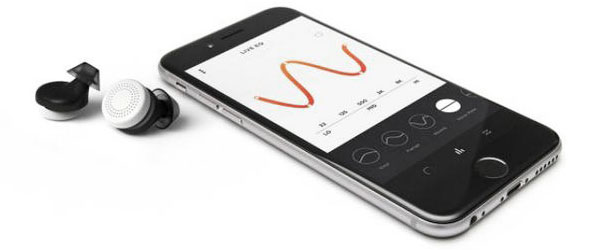Doppler Labs, known for making state-of-the-art ear plugs, on Tuesday launched a Kickstarter campaign for the Here Active Listening system, which takes noise-canceling technology to a new level.
Unlike typical noise-canceling headphones, Here’s Bluetooth earbuds allow a listener to customize ambient sound, not just block it out. Paired with a smartphone app, Here can be used to control the volume of sounds around a listener, mix those sounds with slider controls, and even apply sound effects to them.
The system also contains a portfolio of preset filters. They obviate the need for a listener to fiddle with Here’s controls by automatically addressing some common real-world situations like a baby crying on a plane, screeching subway trains, and low-bass output at live concerts.
“With the Here Active Listening System, we want to give you the tools to have the perfect listening experience,” said Doppler CEO Noah Kraft.
“We all perceive sound differently, but everyone has been to a concert where the audio wasn’t quite right, or has been subjected to a long flight with a screaming baby. Here changes all that, giving control back to the listener by allowing you to curate what you hear and how you hear it,” he continued. “Our goal is to make it so you never have to deal with noise or a bad mix ever again.”
Unique Tech
The technology behind Here is unlike anything on the market today, Doppler claims. It uses a series of signal processing algorithms to target specific frequency ranges and modify sound as it enters a listener’s ears.
The incoming audio is processed in real-time and played back all within 30 microseconds, or less than 1/10,000 of an eye blink, so there’s no perceivable latency for the listener.
Here’s white buds are designed to appear relatively unobtrusive in the ear. Three sizes of silicon tips are packaged with Here to provide a secure and comfortable fit for users.
Doppler estimates the buds will run for six hours on a single charge and the system includes a charging case good for two additional charges on the fly.
The company’s KickStarter campaign, which reached more than two-thirds of its US$250,000 goal within two days of its announcement, has several participation levels.
Name Your Own Filter
At the “cheerleader” levels, donors can get a thank you video and periodic updates on the progress of the product for $5 and a Here t-shirt for $25.
The first 1,000 donors of $179 will receive a Here system when it ships, as well as a t-shirt, and the first 10,000 donors of $199 also will receive a system and t-shirt. List price for Here, which is expected to start shipping in December, will be $249.
Developers who pledge $499 can get a Here unit and early access to the developer’s platform for the system. For $799, donors can not only get early access to the developer’s platform, but also participate in the product’s beta program.
Other donor levels include $999, which includes an invitation to meet with the development teams on the East or West coasts for testing a final prototype; $2,500, which includes attendance at a music-specific event for pretesting the systems; and $5,000 or more, which includes working with Doppler’s engineers on a filter for the system named after you.
Making Live Concerts Worthwhile
With the introduction of Here, Doppler appears to be trying to break into an already popular market, noted Paul Erickson, a senior analyst for IHS.
“It taps into some of the market for noise-canceling headphones,” he told TechNewsWorld.
Here’s appeal may be limited, though, because it doesn’t perform a basic function of its noise-canceling brothers.
“It’s a niche product because it doesn’t stream or play music,” Erickson said.
“This is uncharted ground. Anything that people have previously seen in the mainstream market has had noise-cancellation combined with music listening,” he pointed out.
“It’s a bit of a pioneering effort they’re creating here,” Erickson added. “It’s an aggressive idea. It’s a very innovative variation on the active listening front.”
While starting as a niche product, that could change over time, noted Rob Enderle, president and principal analyst with the Enderle Group.
“This could evolve to become far more useful and encompassing as designs make it more attractive and its features become more broadly appreciated,” he told TechNewsWorld.
One area where Here may become very popular is among concert goers.
“When going to a live concert, often the sound is less than ideal. It likely sounds better to those streaming the event remotely,” Enderle observed.
“With a product like this, you can create sound that should rival a remote viewer with the in-person energy of being at the concert,” he continued. “For a lot of us, this could make going to concerts worth it again.”























































This new technology SOUNDS like a good idea being able to filter other sounds or warp them to however weird you want! I would definitely invest in these "smart-buds" if I were you!